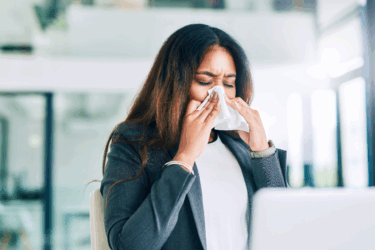It’s been gone for years. So, why is the whooping cough making a comeback? What is it, and how can you protect your family?
 We’d been coughing for weeks. But like most busy moms, I’d ignored my own symptoms because I assumed I’d take a turn for the better any day. I even wrote off my 2-year-old’s coughing and vomiting spells as a virus because she’s the sick one in the family – the one who catches everything and stays sick the longest.
We’d been coughing for weeks. But like most busy moms, I’d ignored my own symptoms because I assumed I’d take a turn for the better any day. I even wrote off my 2-year-old’s coughing and vomiting spells as a virus because she’s the sick one in the family – the one who catches everything and stays sick the longest.
Every family has one, right? It wasn’t until my 4-year-old caught the cough and woke up with broken blood vessels dotting her cheeks that I finally dragged us all to the doctor. You could have knocked me over with a feather when he announced, “You’re all suffering from pertussis, more commonly known as whooping cough.” What? Didn’t that disease disappear with polio and smallpox? Haven’t we all been vaccinated for that? How on earth did this happen?
Common and Contagious
Well it’s apparently happening to a lot of people … a whole lot. Nearly 600,000 American adults contract pertussis each year. It’s so contagious and so prevalent that pediatrician and father Chris Patton, M.D., of Nashville’s Old Harding Pediatric Associates says that according to a study done at Vanderbilt University Medical Center, “One in three adults who came to the emergency room with a chief complaint of cough for more than 10 days tested positive for pertussis.”
It turns out that although most kids receive pertussis protection with their DTaP (diphtheria, tetanus, acellular pertussis) vaccinations as babies, the immunity against the disease wears off five to 10 years after the last shot. That means the majority of the population is at risk. Add in the fact that a non-immune person living in the same household as someone with whooping cough has a 90 percent chance of becoming infected, and you’ve got a recipe for disaster.
The good news is that scientists recently developed a booster vaccine that’s available for anyone older than age 11 who hasn’t received a tetanus and diphtheria booster dose in the last 10 or more years. Even better news? The shot is available at local doctor’s offices right now. But Patton advises, “The initial production of the vaccine is behind the demand. We have it currently available, but it’s a month-to-month availability at this point.”
What the Whoop?
Pertussis or whooping cough is a highly contagious respiratory infection that’s passed from person to person through tiny droplets containing the bordetella pertussis bacteria expelled into the air when someone coughs or sneezes. The time between the initial infection and the first symptoms can range from seven to 21 days, so it’s difficult determine where and how a person contracts it. The bacteria creates toxins that damage the lining of the respiratory tract and act to prevent the body from fighting off other germs, which is why many young children who contract pertussis also develop ear infections, pneumonia and seizures.
“Infants younger than 12 months of age have a high risk of pertussis-related complications, hospitalizations and death,” says Steve Cochi, M.D., acting director of the Center for Disease Control and Prevention’s (CDC) National Immunization Program. Older children and adults frequently experience violent coughing fits that result in vomiting, cracked ribs, facial bruising, petechiae (ruptured blood vessels on the face, neck and chest), bleeding in the whites of the eyes and temporary loss of consciousness. Untreated, a mild case of whooping cough lasts for at least three weeks, while other cases typically last for three months or longer. The Chinese call the illness the “100 day cough.”
Symptoms and Diagnosis
You’d think that with all the hacking and fainting going on that pertussis would be easy to recognize, but both parents and physicians commonly overlook it. “Because so many illnesses have the same complaints as pertussis, it is often times not diagnosed until it’s severe,” explains Patton.
The first symptoms of whooping cough mimic a common cold: a brief low-grade fever, runny nose and a mild cough. During the course of one to two weeks, that irritating little cough gradually morphs into a wet hack that brings up thick mucus, leading sufferers, parents and some doctors to suspect that it’s simply a bad cold with a helpful “productive cough.” But the coughing spells get longer and stronger, some lasting for more than a minute, until the child turns red or blue and struggles for air in between coughs. The sharp, rapid intake of breath in between coughs is what creates the telltale “whooping” sound.
But here’s the catch … some kids whoop and some don’t. What’s more, children can look and feel perfectly healthy in between coughing episodes. After the initial fever, my munchkins maintained strong appetites, slept well at night and ran around like little maniacs all day long. Except for coughing myself to tears a few times a day, I felt fine, too. That’s why entire families can have the disease and never know it.
Doctors miss it all the time. Many cases go undiagnosed because the physician never hears the patient cough, and the kids appear fine at the doctor’s office. Patton says, “A common misperception, even among doctors, is that if a child is immunized, they can’t get pertussis. The truth is that a child who isn’t immunized can die from it, but an immunized child can get very sick and have a bad cough.” Thanks to the CDC’s new immunization booster recommendations and recent media attention about whooping cough, physicians are now realizing how common the illness really is.
But if you suspect you or your children have contracted the disease and your concerns aren’t being properly addressed, wait in the doctor’s office as long as you need to for a coughing spell to occur or videotape an episode at home (first thing in the morning and bedtime are common times) and replay the scene for your pediatrician later. For a definitive pertussis diagnosis, doctors can take a culture of respiratory fluids or perform a blood test.
Treatment and Prevention
Whooping cough is treated with a course of antibiotics, which are most effective when taken during the early stages of the disease. While the drugs won’t instantly stop the coughing spells, they will decrease a person’s contagiousness. A quick round of antibiotics stopped my child’s coughing in a matter of days, but since I’d been sick longer and the immunity from my childhood vaccinations had worn off long ago, I continued to cough – albeit less violently – for another few weeks.
Since pertussis is so contagious, anyone living with or in close contact with someone who has it should also take preventative antibiotics. That includes childcare workers, college students who inhabit the same dorm building and co-workers who may share a telephone or computer keyboard with an infected person.
This blanket treatment and prevention is necessary because infants usually acquire pertussis from siblings and parents at home, when they are still too young to be vaccinated against the infection. Patton explains, “Often teenagers or adults will have mild symptoms or just cold symptoms because they still have some immunity, but they can spread it to younger or older more vulnerable members of the community.” And it’s the very young and very old who are most likely to die from the disease. Just consider that 92 percent of all pertussis hospitalizations in the last decade occurred in infants younger than 6 months old.
While early diagnosis and antibiotics are effective in treating whooping cough, prevention through vaccination is the best solution. Children should receive five doses of the DTaP vaccine before age 6, and now an adolescent/adult booster is available to keep everyone’s immunity up to date. Cochi says, “It’s important that parents vaccinate their infants and children to prevent this serious disease.” Patton agrees, “Immunizations are critical to preventing life threatening illnesses and whooping cough can be fatal to an unimmunized child.”
If you suspect that you or a member of your family or community has whooping cough or if you’re interested in learning more about the new pertussis vaccine for adolescents and adults, call your physician.
Deborah Bohn is local writer and mother.
WHO’S AT RISK
In developed communities, five groups of people are more susceptible than most to get whooping cough. They are:
- Newborns younger than 5 months or until they’ve had their primary whooping cough shots.
- Children who have not received the immunization.
- People older than 10 years but younger than 50 whose immunization has worn off.
- People older than 50 but younger than 60 (roughly) who never got immunized or who never got the infection as children.
- Older people who had whooping cough as a child but whose antibody levels have fallen very low.
Source: whoopingcough.net




